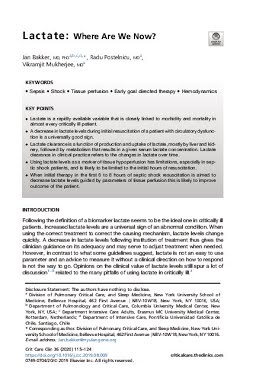There is a tight relationship between lactate levels (and its changes over time) with morbidity and mortality and the presence of tissue hypoxia/hypoperfusion in both models of shock and clinical studies. These findings have placed lactate in the center of guiding resuscitation in patients with increased lactate levels. However, given the complex metabolism and clearance of lactate, especially in sepsis, the actual use of lactate is more complex than suggested by some guidelines. By using other markers of tissue hypoperfusion together with lactate levels provides a more solid framework to guide the initial hours of resuscitation.
| Additional Metadata | |
|---|---|
| , , , , | |
| doi.org/10.1016/j.ccc.2019.08.009, hdl.handle.net/1765/120402 | |
| Critical Care Clinics | |
| Organisation | Department of Intensive Care |
|
Bakker, J., Postelnicu, R. (Radu), & Mukherjee, V. (Vikramjit). (2019). Lactate: Where Are We Now?. Critical Care Clinics. doi:10.1016/j.ccc.2019.08.009 |
|

